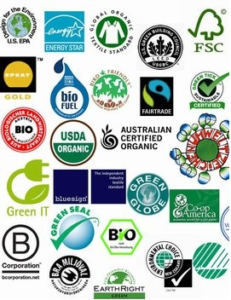
The number of eco-labels in the food industry is expected to continue to proliferate in 2013. Over 200 seals and logos represent some ecological, ethical, ingredient or sustainability attributes in the global food industry. Ecovia Intelligence (Organic Monitor) finds the mushrooming number of eco-labels could have adverse implications.
The majority of eco-labels in the food industry are for organic products, made according to the most sustainable form of agriculture. Organic products comprise the bulk of the estimated US $75 billion eco-labeled food and drink market. Most sales are from Europe and North America which have legally protected organic logos. However, many new organic labels are being introduced in Asia, Latin America and other regions.
The lack of harmonization between these standards is leading to multiple certifications and an exponential rise in organic eco-labels. Over 84 countries have introduced national standards for organic products, with most having separate organic logos.
The global fair trade movement – once united by Fairtrade International (FLO) – is also fragmenting. The departure of Fair Trade USA from the umbrella organization and growing number of new fair trade schemes are increasing the number of fair trade logos and symbols. Although the Fair Trade mark of FLO is the most evident, it is no longer the single identification label for certified fair trade products.
Rainforest Alliance and UTZ Certified have well-established eco-labels for agricultural commodities, such as coffee, tea and cocoa. However, new schemes are gaining popularity for such commodities; they include Bird Friendly Coffee and Starbuck’s Coffee and Farmer Equity (CAFE) practices. Eco-labels are also becoming visible in other product categories; examples are Marine Stewardship Council for sustainable seafood and Certified Humane for meat products.
Concerns about genetically engineered foods have made the Non-GMO Project Verified seal the fastest growing eco-label in the US food industry. As will be shown at the Sustainable Foods Summit, certified product sales reached US $2.4 billion in 2011. The voluntary labeling scheme is predicted to gain in popularity whilst the pro-labeling movement continues to fight for mandatory labeling of genetically engineered foods.
Resource eco-labels are also making headway in the food industry. Many carbon-labeling schemes have been introduced, whilst companies like the Raisio Group are experimenting with water footprint labels. Major challenges for such eco-labels are standardization of methodologies and consumer communications.
Growing consumer awareness of food production methods and sustainability issues has been responsible for the rise of eco-labels in the food industry. With the number and types of eco-labels proliferating, there is a concern that food producers could be discouraged to adopt eco-labels because of the growing disparity between standards and multiple certification costs. A larger concern is the effect on consumers: how can consumers distinguish between the growing number of logos and seals of organic / fair trade products, as well as differentiate them between other eco-labels? With most eco-labels representing some ethical or sustainability attributes, a wider question is whether a new umbrella eco-label will eventually emerge and integrate existing ones.
Sustainable Foods Summit
Ecovia Intelligence (Organic Monitor) presented its latest findings on the global market for eco-labeled food & drink at the North American edition of the Sustainable Foods Summit (San Francisco, January 2013). Leading organizations involved in eco-labeling and organic certification participated at the summit; they included Ecocert, FLO, Fair Trade USA, Rainforest Alliance, NSF International, Control Union, Oregon Tilth, Demeter USA, Certified Humane, Bird Friendly Coffee, Food Alliance, Carbon Free, Non-GMO Project Verified, etc.
The Sustainable Foods Summit gives regular updates on eco-labels in the food industry. Details on upcoming editions of this international series is available from the website
Posted: January 8th 2013
For permission to publish our research insights, please contact our media department

